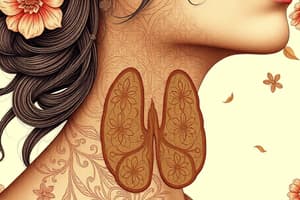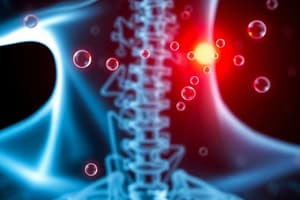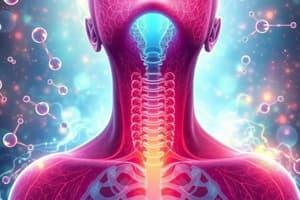Podcast
Questions and Answers
What percentage of circulating T3 and T4 remains unbound in the bloodstream?
What percentage of circulating T3 and T4 remains unbound in the bloodstream?
Less than one percent
What is the primary function of thyrotrophin-releasing hormone (TRH)?
What is the primary function of thyrotrophin-releasing hormone (TRH)?
- To convert T4 to T3
- To stimulate thyroid-stimulating hormone (TSH) secretion (correct)
- To inhibit the thyroid gland
- To increase iodine levels
Hypothyroidism affects over 5% of individuals over age 60 years.
Hypothyroidism affects over 5% of individuals over age 60 years.
True (A)
What is the most common cause of primary hypothyroidism?
What is the most common cause of primary hypothyroidism?
What occurs in the body due to maternal hypothyroidism during pregnancy?
What occurs in the body due to maternal hypothyroidism during pregnancy?
Which autoimmune condition is commonly associated with Hashimoto’s thyroiditis?
Which autoimmune condition is commonly associated with Hashimoto’s thyroiditis?
Postpartum thyroiditis is a permanent condition.
Postpartum thyroiditis is a permanent condition.
What is one of the outcomes of untreated congenital hypothyroidism?
What is one of the outcomes of untreated congenital hypothyroidism?
What is a common risk factor for Hashimoto’s thyroiditis?
What is a common risk factor for Hashimoto’s thyroiditis?
Dietary iodine deficiency can cause ______ in some areas.
Dietary iodine deficiency can cause ______ in some areas.
Flashcards are hidden until you start studying
Study Notes
Thyroid Hormones
- Less than 1% of circulating T3 and T4 in the bloodstream is unbound and can cross cell membranes
- The remaining 99% is bound to transport proteins (TBGs, albumin, other plasma proteins)
- T4 is produced in higher quantities than T3, but T4 is converted to T3 in peripheral tissues (liver, kidneys, muscles)
- T3 is a more active and potent hormone than T4
Hypothalamic-pituitary-thyroid (HPT) axis
- The hypothalamus releases thyrotropin-releasing hormone (TRH)
- TRH stimulates the pituitary gland to release thyroid-stimulating hormone (TSH)
- TSH stimulates the thyroid gland to grow and produce T3 and T4
- T3 and T4 negatively feedback on the hypothalamus and pituitary
Hypothyroidism
- Affects over 1% of the general population and 5% of individuals over 60 years old
- 85% of individuals affected are women
- Hypothyroidism during pregnancy leads to offspring with lower IQ scores
- Congenital hypothyroidism occurs in 1:4000 births and can lead to cretinism and permanent cognitive impairment
Etiology of Primary Hypothyroidism
- Autoimmune disease (Hashimoto’s thyroiditis) accounts for over 90% of cases
- Thyroid failure following 131I or surgical treatment of thyrotoxicosis is another significant cause
- Iodine deficiency is endemic in some areas
Hashimoto’s Thyroiditis
- More common in women
- Characterized by destructive lymphoid infiltration of the thyroid gland
- Can cause thyroid enlargement (goitre)
- Increased risk of thyroid lymphoma
- Around 25% of patients are hypothyroid at presentation, with the remainder at risk of developing hypothyroidism in the future
- Antithyroid peroxidase antibodies are present in more than 90% of patients
- Patients may be hypothyroid or euthyroid, but can go through an initial toxic phase ('Hashi-toxicity')
Postpartum Thyroiditis
- Usually a transient phenomenon following pregnancy or miscarriage
- Can cause hyperthyroidism, hypothyroidism, or both sequentially
- Believed to result from immune system modifications during pregnancy
- Often self-limiting but can proceed to permanent hypothyroidism
- Can be misdiagnosed as postpartum depression
Defects of Hormone Synthesis
- Iodine deficiency occurs in areas where endemic goitre is common
- Patients can be euthyroid or hypothyroid
- Other defects of hormone synthesis (e.g., dyshormonogenesis) are less common
Studying That Suits You
Use AI to generate personalized quizzes and flashcards to suit your learning preferences.




